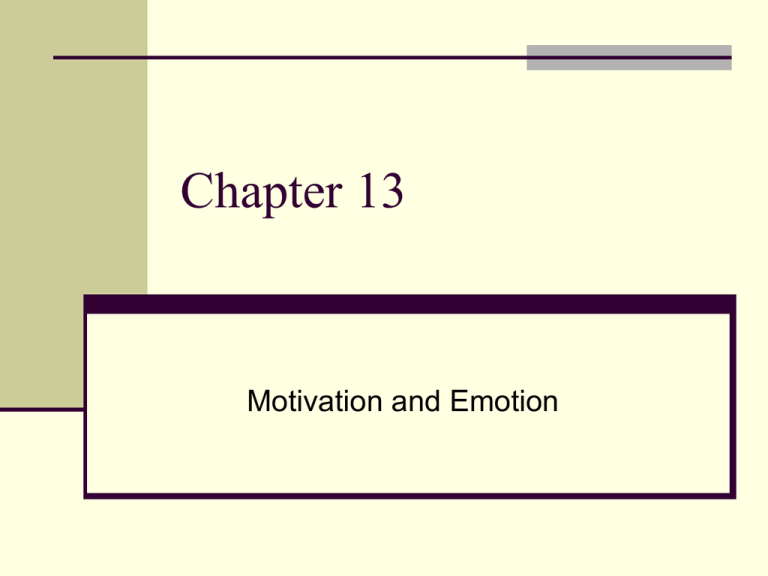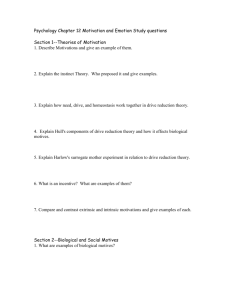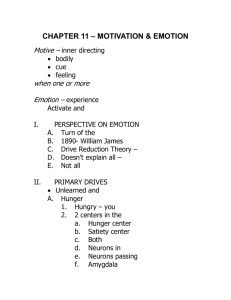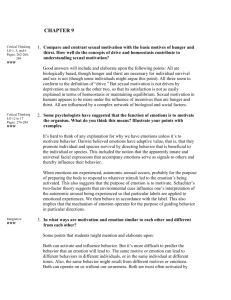Chapter13PSYCH
advertisement

Chapter 13 Motivation and Emotion Motives and emotions Motives are specific inner needs and wants that direct us toward a goal Emotions are feelings or experiences such as joy or surprise which also activate behavior, but in a less predictable way than motives Drive Reduction Theory- states that we have certain drives like thirst, hunger, and tiredness. When we experience those drives we have a need to reduce those unpleasant states of tension and return to our bodies state of balance called homeostasis. Primary Drive An unlearned drive that triggers a state of arousal or tension is called a primary drive. Ex. Hunger, thirst or sex. Hunger is caused by a drop of simple sugar glucose in our bodies. When our level of glucose drops below a certain level the hunger center of the brain is triggered. The stomach sends the message to the brain. When food enters the small intestine, hormones are sent to the brain to reduce the feelings of hunger. HOLY COW!!! Look at the rat on page 304! There are two regulators of thirst… One regulator: Level of fluids in body’s cells. Salt intake causes water to leave these cells. When the level of sodium in the blood gets low enough the thirst center of the brain is triggered. Other regulator: level of water outside the body’s cells. When the amount dips too low, the amount of blood reaching the kidneys gets low. Brain is then triggered by lack of blood to kidneys and thirst is created Sex Although sex is not necessary for the survival of one person it is necessary for the survival of a species. Because of this it is considered a primary drive Men and women both have testosterone which is the strongest biological influence of the sex drive. It is also said that pheromones are given off to affect the sexual readiness of others Sex The sexual response cycle for humans progresses through 4 stages: Arousal, plateau, orgasm, and resolution. Men tend to be more aroused by visual cues whereas women tend to be more aroused by touch What we consider to be sexually attractive is influenced by society and our culture. Stimulus Motives There are two stimulus motives you need to know. The desire to manipulate and contact. The desire to manipulate is related to the need to know about something or gain knowledge Manipulation involves holding something, touching it, playing with it etc. Contact is needed for closeness and affection Learned motives Aggression and Sexual Coercion Aggression is any behavior that is intended to inflict physical or psychological harm to others. Most psychologists believe aggression is a response modeled after the behavior we see and learn from others. Sexual coercion Is a term used to describe the variety of behaviors from rape to a less extreme form like sexual harassment Research has found that when studying convicted rapists the researchers found that power, anger, and hatred are most commonly given for the motives for rape. Abraham Maslow Came up with a hierarchy of needs. The lower motives are simple motives needed for survival. As you go up the pyramid and move to the higher motives they become more complex. Lower motives must be met first before higher motives can be met. Yerkes-Dodson This law says the more complex the task the more chance our emotions will disrupt our performance. For example being angry may not effect your ability to walk but might affect your ability to drive because that task is more complex. Robert Plutchik came up with the idea that humans and animals experience 8 basic emotions. Plutchik’s 8 basic emotions Fear Surprise Sadness Disgust Anger Anticipation Joy Acceptance Plutchik’s 8 basic emotions cont. He believed that a combination of two of these can produce a wider range of emotions. For example, a combination of joy and acceptance produce love. Assignment Create a flip chart with Maslow’s Hierarchy of needs. Use definitions from the book to explain each step! Theories in Psych James Lange theory says that stimuli causes physiological changes in our bodies and emotions result from these changes Canon Bard theory says that emotions and bodily responses occur simultaneously. For example, if we were approached by a bear in the woods the hair would stand up on our neck and we would become frightened at the same time.





